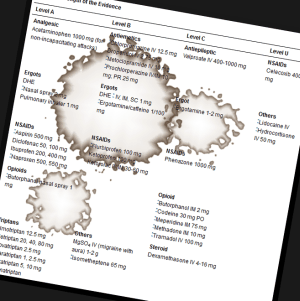Can this Procedure Teach Your Body to avoid Migraine?
No one really wants to be tied to taking a pill for the rest of their lives, or paying for a treatment every week for years and years. There are some treatments that are emerging which may lead to longer term solutions.
Back in 2010, we talked about a review that was published in the journal Headache about nerve blocks and trigger point injections. The authors of the study called for more research to be done in this very promising area of research.
You’ll be glad to hear that the research is continuing. One aspect of this type of treatment is injections in the area of the sphenopalatine ganglion. The sphenopalatine ganglion is a nerve cluster behind the nose, that has been related to migraine.
Actually, the sphenopalatine ganglion is a key player in cluster headache, and so a fair bit of research has been done specifically for cluster.
Earlier this month, at the Society of Interventional Radiology‘s annual meeting, researchers reported on a study on image guided intranasal sphenopalatine ganglion blocks. Here’s how it works.
The treatment is “minimally invasive”. There are no cuts, needles, or stitches. A small tube is inserted in the nose and lidocaine is administered to the nerve cluster. That’s it.
In the study, patients started with headache pain averaging 8.25 out of 10. After 30 days, the average had dropped to 5.25.
A miracle cure? Certainly not. But let’s look closer.
For the next month, patients found their pain dropped by 36%. But that’s not all. 88% used less – or even no – migraine medication over that month.
What’s next? The researchers want to know how patients are doing after 6 months.
For such a preliminary study, these are hopeful results. What if the procedure was improved? The medication was adjusted? Would there be a way to improve things for months – a year – five years – ?
If you have chronic migraine, imagine if you could cut your medication in half, while also cutting your pain in half.
Sphenopalatine ganglion blocks remain an important area of research, not only for cluster, but for migraine as well.
For more information:
- Study abstract: Image-guided sphenopalatine ganglion blocks: an IR solution for chronic headaches
- Press release: Image-guided treatment shown to break the migraine cycle
- Discussion at ScienceDaily: Image-guided treatment shown to break the migraine cycle


 Levadex was still in the news last year, but under a brand new name. Semprana is the new name for Levadex, a new formulation of dihydroergotamine mesylate (DHE). It’s now owned by Allergan, the makers of Botox.
Levadex was still in the news last year, but under a brand new name. Semprana is the new name for Levadex, a new formulation of dihydroergotamine mesylate (DHE). It’s now owned by Allergan, the makers of Botox. This, of course, does not mean that these medications will work the best for you. There is a lot of variation within migraine, and your doctor will help you decide where to start.
This, of course, does not mean that these medications will work the best for you. There is a lot of variation within migraine, and your doctor will help you decide where to start.